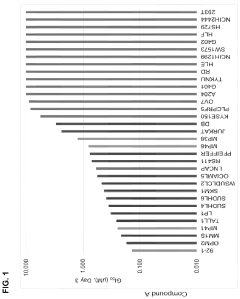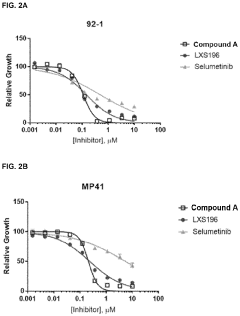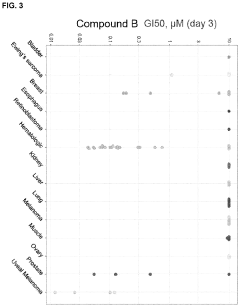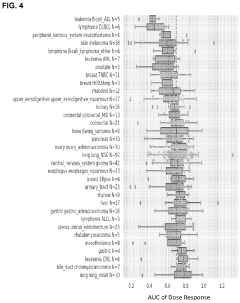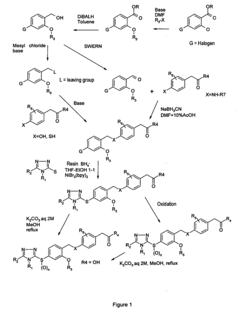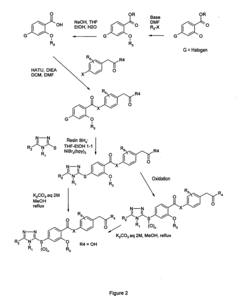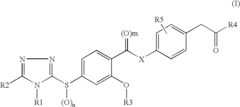The Role of Geometric Isomers in Peptide and Nucleotide Synthesis
AUG 1, 20259 MIN READ
Generate Your Research Report Instantly with AI Agent
Patsnap Eureka helps you evaluate technical feasibility & market potential.
Geometric Isomers in Biomolecule Synthesis: Background and Objectives
Geometric isomers play a crucial role in the synthesis of biomolecules, particularly in the realm of peptides and nucleotides. The study of these isomers has been a cornerstone of biochemistry and organic synthesis for decades, with significant implications for drug development, molecular biology, and biotechnology. The field has evolved from basic structural elucidation to advanced applications in precision medicine and nanomaterials.
The primary objective of researching geometric isomers in biomolecule synthesis is to understand and control the spatial arrangement of atoms within molecules, which directly impacts their biological activity and chemical properties. This knowledge is fundamental to designing more effective drugs, improving the efficiency of biochemical processes, and developing novel materials with specific functionalities.
Historically, the recognition of geometric isomerism in biomolecules dates back to the late 19th century, with pioneering work by van't Hoff and Le Bel on carbon stereochemistry. However, it was not until the mid-20th century that the full implications of geometric isomerism in peptides and nucleotides were realized, coinciding with advancements in structural biology and analytical techniques.
The field has seen remarkable progress, driven by technological innovations such as X-ray crystallography, NMR spectroscopy, and computational modeling. These tools have enabled researchers to elucidate the precise three-dimensional structures of complex biomolecules and understand how subtle changes in geometry can lead to profound differences in function.
In peptide synthesis, the cis-trans isomerism of peptide bonds has been a focal point of research. The ability to control this isomerism is crucial for creating peptides with desired conformations and biological activities. Similarly, in nucleotide synthesis, the geometric arrangement of bases and sugar-phosphate backbones is essential for the formation of stable DNA and RNA structures.
Recent trends in the field include the exploration of non-natural amino acids and nucleotides with unique geometric properties, the development of catalysts that can selectively produce specific isomers, and the application of machine learning algorithms to predict and design isomeric structures with tailored functions.
Looking forward, the study of geometric isomers in biomolecule synthesis aims to push the boundaries of precision medicine, enabling the creation of highly specific and effective therapeutic agents. It also holds promise for advancing the field of synthetic biology, where engineered biomolecules could be used to create novel cellular functions and materials.
The primary objective of researching geometric isomers in biomolecule synthesis is to understand and control the spatial arrangement of atoms within molecules, which directly impacts their biological activity and chemical properties. This knowledge is fundamental to designing more effective drugs, improving the efficiency of biochemical processes, and developing novel materials with specific functionalities.
Historically, the recognition of geometric isomerism in biomolecules dates back to the late 19th century, with pioneering work by van't Hoff and Le Bel on carbon stereochemistry. However, it was not until the mid-20th century that the full implications of geometric isomerism in peptides and nucleotides were realized, coinciding with advancements in structural biology and analytical techniques.
The field has seen remarkable progress, driven by technological innovations such as X-ray crystallography, NMR spectroscopy, and computational modeling. These tools have enabled researchers to elucidate the precise three-dimensional structures of complex biomolecules and understand how subtle changes in geometry can lead to profound differences in function.
In peptide synthesis, the cis-trans isomerism of peptide bonds has been a focal point of research. The ability to control this isomerism is crucial for creating peptides with desired conformations and biological activities. Similarly, in nucleotide synthesis, the geometric arrangement of bases and sugar-phosphate backbones is essential for the formation of stable DNA and RNA structures.
Recent trends in the field include the exploration of non-natural amino acids and nucleotides with unique geometric properties, the development of catalysts that can selectively produce specific isomers, and the application of machine learning algorithms to predict and design isomeric structures with tailored functions.
Looking forward, the study of geometric isomers in biomolecule synthesis aims to push the boundaries of precision medicine, enabling the creation of highly specific and effective therapeutic agents. It also holds promise for advancing the field of synthetic biology, where engineered biomolecules could be used to create novel cellular functions and materials.
Market Demand for Precise Peptide and Nucleotide Synthesis
The market demand for precise peptide and nucleotide synthesis has been experiencing significant growth, driven by advancements in biotechnology, pharmaceutical research, and personalized medicine. The increasing focus on geometric isomers in these processes has further amplified this demand, as researchers and industries recognize the critical role of spatial arrangements in molecular function and efficacy.
In the pharmaceutical sector, the need for highly specific and pure peptides and nucleotides has surged due to the development of targeted therapies and biologics. Geometric isomers play a crucial role in determining the biological activity and therapeutic potential of these molecules. As a result, pharmaceutical companies are investing heavily in technologies that can produce precise isomeric forms, leading to a growing market for specialized synthesis services and equipment.
The biotechnology industry has also been a major driver of demand for precise peptide and nucleotide synthesis. With the rise of gene editing technologies like CRISPR and the increasing use of synthetic biology in various applications, the need for high-quality, isomer-specific nucleotides has skyrocketed. This demand extends to research institutions and academic laboratories, where the ability to synthesize and study specific geometric isomers is essential for advancing our understanding of molecular biology and developing new biotechnological tools.
In the field of diagnostics, the importance of geometric isomers in nucleic acid-based tests has become increasingly apparent. The specificity and sensitivity of diagnostic assays often depend on the precise spatial configuration of nucleotides, driving demand for synthesis technologies that can produce the correct isomeric forms consistently and at scale.
The emerging field of personalized medicine has also contributed to the growing market for precise peptide and nucleotide synthesis. As treatments become more tailored to individual genetic profiles, the need for custom-synthesized peptides and nucleotides with specific isomeric configurations has increased. This trend is expected to continue as personalized therapies become more widespread and sophisticated.
Agricultural biotechnology represents another significant market segment driving demand for precise synthesis. The development of genetically modified crops and biopesticides often requires the use of specific nucleotide sequences, with geometric isomers playing a crucial role in their effectiveness. As global food security challenges persist, this sector is likely to continue fueling demand for advanced synthesis capabilities.
Overall, the market for precise peptide and nucleotide synthesis, with a focus on geometric isomers, is projected to expand substantially in the coming years. This growth is underpinned by technological advancements, increasing research and development activities, and the broadening applications of these molecules across multiple industries.
In the pharmaceutical sector, the need for highly specific and pure peptides and nucleotides has surged due to the development of targeted therapies and biologics. Geometric isomers play a crucial role in determining the biological activity and therapeutic potential of these molecules. As a result, pharmaceutical companies are investing heavily in technologies that can produce precise isomeric forms, leading to a growing market for specialized synthesis services and equipment.
The biotechnology industry has also been a major driver of demand for precise peptide and nucleotide synthesis. With the rise of gene editing technologies like CRISPR and the increasing use of synthetic biology in various applications, the need for high-quality, isomer-specific nucleotides has skyrocketed. This demand extends to research institutions and academic laboratories, where the ability to synthesize and study specific geometric isomers is essential for advancing our understanding of molecular biology and developing new biotechnological tools.
In the field of diagnostics, the importance of geometric isomers in nucleic acid-based tests has become increasingly apparent. The specificity and sensitivity of diagnostic assays often depend on the precise spatial configuration of nucleotides, driving demand for synthesis technologies that can produce the correct isomeric forms consistently and at scale.
The emerging field of personalized medicine has also contributed to the growing market for precise peptide and nucleotide synthesis. As treatments become more tailored to individual genetic profiles, the need for custom-synthesized peptides and nucleotides with specific isomeric configurations has increased. This trend is expected to continue as personalized therapies become more widespread and sophisticated.
Agricultural biotechnology represents another significant market segment driving demand for precise synthesis. The development of genetically modified crops and biopesticides often requires the use of specific nucleotide sequences, with geometric isomers playing a crucial role in their effectiveness. As global food security challenges persist, this sector is likely to continue fueling demand for advanced synthesis capabilities.
Overall, the market for precise peptide and nucleotide synthesis, with a focus on geometric isomers, is projected to expand substantially in the coming years. This growth is underpinned by technological advancements, increasing research and development activities, and the broadening applications of these molecules across multiple industries.
Current Challenges in Geometric Isomer Control
The control of geometric isomers in peptide and nucleotide synthesis presents several significant challenges that researchers and industry professionals continue to grapple with. One of the primary obstacles is the inherent complexity of isomeric structures, which can lead to unpredictable behavior during synthesis processes.
Stereospecificity remains a critical issue, particularly in the synthesis of complex peptides and nucleotides. Achieving precise control over the spatial arrangement of atoms in these molecules is crucial for their biological activity and function. However, current synthetic methods often struggle to consistently produce the desired isomeric forms with high purity and yield.
Another major challenge lies in the development of efficient and scalable separation techniques for geometric isomers. While chromatographic methods have shown promise, they often suffer from limitations in throughput and cost-effectiveness when applied to large-scale production. This bottleneck significantly impacts the commercial viability of many peptide and nucleotide-based therapeutics.
The dynamic nature of isomerization processes further complicates matters. Environmental factors such as temperature, pH, and solvent conditions can induce unwanted isomeric transitions, compromising the stability and efficacy of the final products. Developing robust strategies to maintain isomeric integrity throughout synthesis, purification, and storage stages remains an ongoing challenge.
Analytical techniques for rapid and accurate identification and quantification of geometric isomers also present difficulties. While advanced spectroscopic methods have improved our ability to characterize isomeric mixtures, there is still a need for more sensitive and high-throughput analytical tools capable of distinguishing subtle structural differences.
The challenge of predicting and controlling isomerization during solid-phase synthesis is particularly pronounced. The confined environment of solid supports can influence isomeric preferences in ways that are not fully understood, leading to unexpected outcomes and reduced yields.
Lastly, the development of catalysts and reagents that can selectively promote the formation of specific geometric isomers remains an area of intense research. While progress has been made in asymmetric synthesis, achieving high levels of stereoselectivity for complex peptides and nucleotides continues to be a formidable task.
Addressing these challenges will require interdisciplinary approaches, combining advances in synthetic chemistry, analytical techniques, and computational modeling. As the demand for precise control over molecular architecture in pharmaceuticals and biotechnology grows, overcoming these hurdles in geometric isomer control will be crucial for realizing the full potential of peptide and nucleotide-based technologies.
Stereospecificity remains a critical issue, particularly in the synthesis of complex peptides and nucleotides. Achieving precise control over the spatial arrangement of atoms in these molecules is crucial for their biological activity and function. However, current synthetic methods often struggle to consistently produce the desired isomeric forms with high purity and yield.
Another major challenge lies in the development of efficient and scalable separation techniques for geometric isomers. While chromatographic methods have shown promise, they often suffer from limitations in throughput and cost-effectiveness when applied to large-scale production. This bottleneck significantly impacts the commercial viability of many peptide and nucleotide-based therapeutics.
The dynamic nature of isomerization processes further complicates matters. Environmental factors such as temperature, pH, and solvent conditions can induce unwanted isomeric transitions, compromising the stability and efficacy of the final products. Developing robust strategies to maintain isomeric integrity throughout synthesis, purification, and storage stages remains an ongoing challenge.
Analytical techniques for rapid and accurate identification and quantification of geometric isomers also present difficulties. While advanced spectroscopic methods have improved our ability to characterize isomeric mixtures, there is still a need for more sensitive and high-throughput analytical tools capable of distinguishing subtle structural differences.
The challenge of predicting and controlling isomerization during solid-phase synthesis is particularly pronounced. The confined environment of solid supports can influence isomeric preferences in ways that are not fully understood, leading to unexpected outcomes and reduced yields.
Lastly, the development of catalysts and reagents that can selectively promote the formation of specific geometric isomers remains an area of intense research. While progress has been made in asymmetric synthesis, achieving high levels of stereoselectivity for complex peptides and nucleotides continues to be a formidable task.
Addressing these challenges will require interdisciplinary approaches, combining advances in synthetic chemistry, analytical techniques, and computational modeling. As the demand for precise control over molecular architecture in pharmaceuticals and biotechnology grows, overcoming these hurdles in geometric isomer control will be crucial for realizing the full potential of peptide and nucleotide-based technologies.
Existing Strategies for Geometric Isomer Management
01 Synthesis and separation of geometric isomers
Methods for synthesizing and separating geometric isomers, including techniques for controlling the formation of specific isomers during chemical reactions and purification processes to isolate desired isomers from mixtures.- Synthesis and separation of geometric isomers: Methods for synthesizing and separating geometric isomers, including techniques for controlling the formation of specific isomers during chemical reactions and purification processes to isolate desired isomers from mixtures.
- Characterization and analysis of geometric isomers: Techniques for identifying and analyzing geometric isomers, including spectroscopic methods, chromatography, and computational modeling to determine molecular structures and properties of different isomeric forms.
- Applications of geometric isomers in pharmaceuticals: Utilization of geometric isomers in drug development and pharmaceutical formulations, focusing on the different biological activities and therapeutic effects of various isomeric forms of active compounds.
- Geometric isomers in materials science and engineering: Exploration of geometric isomers in the development of advanced materials, including their role in determining physical properties, optical characteristics, and performance in various applications such as electronics and energy storage.
- Computational methods for studying geometric isomers: Development and application of computational techniques for modeling, predicting, and visualizing geometric isomers, including molecular dynamics simulations, quantum chemical calculations, and machine learning approaches.
02 Characterization and analysis of geometric isomers
Techniques for identifying and analyzing geometric isomers, including spectroscopic methods, chromatography, and computational modeling to determine molecular structures and properties of different isomeric forms.Expand Specific Solutions03 Applications of geometric isomers in pharmaceuticals
Utilization of geometric isomers in drug development and pharmaceutical formulations, focusing on the different biological activities and therapeutic effects of various isomeric forms of active compounds.Expand Specific Solutions04 Geometric isomers in materials science and engineering
Exploration of geometric isomers in the development of advanced materials, including their role in determining physical properties, optical characteristics, and performance in various applications such as electronics and energy storage.Expand Specific Solutions05 Computational methods for studying geometric isomers
Development and application of computational techniques for modeling, predicting, and visualizing geometric isomers, including molecular dynamics simulations, quantum chemical calculations, and machine learning approaches.Expand Specific Solutions
Key Players in Biomolecule Synthesis Industry
The field of geometric isomers in peptide and nucleotide synthesis is in a growth phase, with increasing market size and technological advancements. The global peptide therapeutics market is expected to reach $50 billion by 2026, driven by the rising demand for targeted therapies. Companies like Shenzhen Winkey Technology, Rein Therapeutics, and Palatin Technologies are at the forefront, developing novel peptide-based drugs. In nucleotide synthesis, players such as Novartis and Glaxo Group are investing heavily in research and development. The technology is maturing rapidly, with academic institutions like New York University and Jilin University contributing significant research. However, challenges in scalability and cost-effectiveness remain, presenting opportunities for further innovation and market expansion.
Novartis AG
Technical Solution: Novartis AG has developed innovative approaches to peptide and nucleotide synthesis utilizing geometric isomers. Their technology involves the use of cis-trans isomerization to control the three-dimensional structure of peptides, enhancing their biological activity and stability[1]. They have also implemented a novel method for nucleotide synthesis that exploits the geometric isomerism of ribose sugars to improve the efficiency of oligonucleotide production[2]. This approach has led to the development of more effective antisense oligonucleotides for therapeutic applications[3]. Novartis has further expanded this technology to create cyclic peptides with improved pharmacokinetic properties, leveraging the unique conformational constraints provided by geometric isomers[4].
Strengths: Advanced control over peptide structure and function, improved oligonucleotide synthesis efficiency, and enhanced drug delivery capabilities. Weaknesses: Potential complexity in large-scale production and higher costs associated with specialized isomer-based techniques.
Massachusetts Institute of Technology
Technical Solution: MIT has pioneered research in the application of geometric isomers for peptide and nucleotide synthesis. Their approach focuses on using photoswitchable azobenzene moieties to create peptides with controllable conformations[5]. This technique allows for the dynamic regulation of peptide structure and function in response to light stimuli. In nucleotide synthesis, MIT researchers have developed a method utilizing geometric isomerism of phosphoramidite intermediates to enhance the yield and purity of synthetic oligonucleotides[6]. They have also explored the role of backbone geometric isomers in DNA and RNA, leading to insights into nucleic acid structure and function[7].
Strengths: Cutting-edge photoswitchable peptide technology, improved oligonucleotide synthesis methods, and fundamental insights into nucleic acid structure. Weaknesses: Some techniques may be limited to laboratory-scale applications and require specialized equipment.
Innovations in Isomer-Selective Catalysis
Compounds and uses thereof
PatentPendingUS20230145003A1
Innovation
- Development of specific compounds that modulate the BAF complex by inhibiting BRG1 and/or BRM activity, which can be used alone or in combination with other pharmaceutically active agents to treat disorders like cancer.
Novel modulators of the PPAR-type receptors and pharmaceutical/cosmetic applications thereof
PatentInactiveUS20070054907A1
Innovation
- Development of a novel class of PPAR-modulating compounds represented by the general formula (I), which include specific alkyl, aryl, and heteroaryl radicals, capable of forming geometric and optical isomers, tautomeric forms, and salts, designed to modulate PPARα, δ, and γ receptors, thereby regulating skin lipid metabolism and treating various dermatological conditions.
Regulatory Considerations for Synthetic Biomolecules
The regulatory landscape for synthetic biomolecules, including geometric isomers in peptide and nucleotide synthesis, is complex and evolving. Regulatory bodies such as the FDA, EMA, and other international agencies have established guidelines and frameworks to ensure the safety, efficacy, and quality of these novel compounds.
One of the primary considerations is the characterization and control of geometric isomers. Regulatory agencies require thorough analytical methods to identify, quantify, and control these isomers throughout the manufacturing process. This includes the development of validated analytical techniques, such as high-performance liquid chromatography (HPLC) or nuclear magnetic resonance (NMR) spectroscopy, to accurately determine isomeric ratios and purity.
Stability testing is another crucial aspect of regulatory compliance. Manufacturers must demonstrate the stability of geometric isomers under various storage conditions and throughout the product's shelf life. This involves conducting long-term stability studies and providing data on potential isomerization or degradation pathways.
Good Manufacturing Practices (GMP) play a vital role in the regulatory framework for synthetic biomolecules. Manufacturers must implement robust quality control systems to ensure consistent production of geometric isomers with the desired configuration. This includes process validation, in-process controls, and final product testing to guarantee batch-to-batch consistency.
Regulatory agencies also emphasize the importance of understanding the biological activity and potential toxicity of different geometric isomers. Manufacturers are required to provide comprehensive data on the pharmacological and toxicological profiles of each isomer, as well as their potential interactions and effects on the overall efficacy and safety of the final product.
The regulatory pathway for synthetic biomolecules often involves early engagement with regulatory authorities. Pre-submission meetings and scientific advice consultations are encouraged to address specific challenges related to geometric isomers and to align development strategies with regulatory expectations.
As the field of synthetic biology advances, regulatory frameworks are adapting to keep pace. Emerging technologies, such as artificial intelligence and machine learning, are being explored for their potential to enhance the prediction and control of geometric isomers in peptide and nucleotide synthesis. Regulatory agencies are actively working on guidelines to address these novel approaches and ensure their appropriate integration into the development and manufacturing processes.
One of the primary considerations is the characterization and control of geometric isomers. Regulatory agencies require thorough analytical methods to identify, quantify, and control these isomers throughout the manufacturing process. This includes the development of validated analytical techniques, such as high-performance liquid chromatography (HPLC) or nuclear magnetic resonance (NMR) spectroscopy, to accurately determine isomeric ratios and purity.
Stability testing is another crucial aspect of regulatory compliance. Manufacturers must demonstrate the stability of geometric isomers under various storage conditions and throughout the product's shelf life. This involves conducting long-term stability studies and providing data on potential isomerization or degradation pathways.
Good Manufacturing Practices (GMP) play a vital role in the regulatory framework for synthetic biomolecules. Manufacturers must implement robust quality control systems to ensure consistent production of geometric isomers with the desired configuration. This includes process validation, in-process controls, and final product testing to guarantee batch-to-batch consistency.
Regulatory agencies also emphasize the importance of understanding the biological activity and potential toxicity of different geometric isomers. Manufacturers are required to provide comprehensive data on the pharmacological and toxicological profiles of each isomer, as well as their potential interactions and effects on the overall efficacy and safety of the final product.
The regulatory pathway for synthetic biomolecules often involves early engagement with regulatory authorities. Pre-submission meetings and scientific advice consultations are encouraged to address specific challenges related to geometric isomers and to align development strategies with regulatory expectations.
As the field of synthetic biology advances, regulatory frameworks are adapting to keep pace. Emerging technologies, such as artificial intelligence and machine learning, are being explored for their potential to enhance the prediction and control of geometric isomers in peptide and nucleotide synthesis. Regulatory agencies are actively working on guidelines to address these novel approaches and ensure their appropriate integration into the development and manufacturing processes.
Environmental Impact of Isomer-Specific Synthesis Methods
The environmental impact of isomer-specific synthesis methods in peptide and nucleotide production is a critical consideration in the broader context of sustainable chemistry. These methods, while essential for creating precise molecular structures, can have significant ecological implications that warrant careful examination.
Conventional synthesis techniques often involve the use of harsh solvents, high-energy processes, and toxic reagents, which can lead to substantial environmental pollution. However, isomer-specific methods have the potential to mitigate some of these issues by increasing reaction efficiency and reducing waste. For instance, stereoselective catalysis can dramatically improve the yield of desired isomers, thereby minimizing the generation of unwanted by-products that would otherwise require energy-intensive separation and disposal processes.
The use of green solvents and renewable resources in isomer-specific syntheses is an emerging trend that promises to further reduce the environmental footprint of peptide and nucleotide production. Water-based reactions and bio-catalytic processes are being explored as alternatives to traditional organic solvent-based methods, offering the dual benefits of reduced toxicity and improved biodegradability.
Energy consumption is another critical factor in assessing the environmental impact of these synthesis methods. While some isomer-specific techniques may require specialized equipment or controlled conditions that could increase energy usage, the overall energy balance often favors these methods due to their higher selectivity and reduced need for extensive purification steps.
The lifecycle analysis of isomer-specific synthesis reveals potential benefits in terms of resource conservation. By producing the desired isomers with greater precision, these methods can lead to more efficient use of raw materials, reducing the strain on natural resources and minimizing the carbon footprint associated with the production and transportation of chemical precursors.
However, challenges remain in scaling up these environmentally friendly approaches for industrial production. The development of robust, large-scale processes that maintain the selectivity and efficiency of laboratory-scale reactions is an ongoing area of research. Additionally, the environmental impact of producing and disposing of specialized catalysts used in some isomer-specific methods must be carefully evaluated to ensure a net positive ecological outcome.
As regulatory frameworks increasingly emphasize environmental protection, the adoption of greener isomer-specific synthesis methods is likely to accelerate. This shift not only addresses ecological concerns but also aligns with the principles of atom economy and process intensification, which are central to sustainable chemical manufacturing practices.
Conventional synthesis techniques often involve the use of harsh solvents, high-energy processes, and toxic reagents, which can lead to substantial environmental pollution. However, isomer-specific methods have the potential to mitigate some of these issues by increasing reaction efficiency and reducing waste. For instance, stereoselective catalysis can dramatically improve the yield of desired isomers, thereby minimizing the generation of unwanted by-products that would otherwise require energy-intensive separation and disposal processes.
The use of green solvents and renewable resources in isomer-specific syntheses is an emerging trend that promises to further reduce the environmental footprint of peptide and nucleotide production. Water-based reactions and bio-catalytic processes are being explored as alternatives to traditional organic solvent-based methods, offering the dual benefits of reduced toxicity and improved biodegradability.
Energy consumption is another critical factor in assessing the environmental impact of these synthesis methods. While some isomer-specific techniques may require specialized equipment or controlled conditions that could increase energy usage, the overall energy balance often favors these methods due to their higher selectivity and reduced need for extensive purification steps.
The lifecycle analysis of isomer-specific synthesis reveals potential benefits in terms of resource conservation. By producing the desired isomers with greater precision, these methods can lead to more efficient use of raw materials, reducing the strain on natural resources and minimizing the carbon footprint associated with the production and transportation of chemical precursors.
However, challenges remain in scaling up these environmentally friendly approaches for industrial production. The development of robust, large-scale processes that maintain the selectivity and efficiency of laboratory-scale reactions is an ongoing area of research. Additionally, the environmental impact of producing and disposing of specialized catalysts used in some isomer-specific methods must be carefully evaluated to ensure a net positive ecological outcome.
As regulatory frameworks increasingly emphasize environmental protection, the adoption of greener isomer-specific synthesis methods is likely to accelerate. This shift not only addresses ecological concerns but also aligns with the principles of atom economy and process intensification, which are central to sustainable chemical manufacturing practices.
Unlock deeper insights with Patsnap Eureka Quick Research — get a full tech report to explore trends and direct your research. Try now!
Generate Your Research Report Instantly with AI Agent
Supercharge your innovation with Patsnap Eureka AI Agent Platform!
